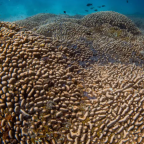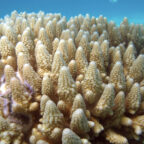
Scientists at the Regional Aquaculture and Fisheries Research Center in Puerto Morelos, Quintana Roo managed, for the first time in Mexico, to reproduce corals sexually in controlled environments and in an assisted manner, a historic achievement that gives hope for coral reef repopulation in the Mexican Caribbean.
The team led by Dr. Claudia Padilla, from Inapesca, has been working on coral reproduction for 10 years, but this is the first time that they have spawned these organisms in a controlled pond, which simulates sea conditions in temperature, light, waves, and current.
What is coral?
Coral reproduction is a complex process, for which it is necessary to first understand what a coral is.
These are colonial animals made up of a calcium carbonate base (skeleton) that covers a layer of living tissue from small individuals called polyps. Inside these polyps, microalgae called zooxanthellae live in symbiosis, which gives corals that striking color.
Therefore, a “coral colony” is the name given to the calcium carbonate rocky structure covered by hundreds, thousands, or even millions of polyps, depending on the coral’s age. In Quintana Roo there are more than 40 species of corals, each with its particular physical and biological complexities.
Coral reproduction
“Corals have two types of reproduction, sexual and asexual”, explains Dr. Claudia Padilla.
Asexual reproduction consists of fragmentation of a colony: if a coral colony is broken by the force of the sea during a hurricane, or by the anchor of a ship, it is possible to fix those fragments and they will continue to grow.
The Coral Reproduction Laboratory has collected hundreds of coral fragments from larger, hardier colonies to grow in controlled environments, with clean water, and then to reforest reef sites. This method has been applied mainly in the corals of the Acropora palmataspecies, popularly known as “elkhorn” coral, which population in the region was almost exterminated during the 1980s by a disease, the researcher said.
“Sexual reproduction is the natural process of fertilization that corals go through to multiply, like all animal species. Corals reproduce once or several times a year, depending on the type of coral, and at certain times and days, depending on the sunset or the position of the moon”, indicates Andrés Morales, one of the laboratory technicians.
In the process without human intervention, each coral colony releases eggs called “gametes”. These gametes are one-millimeter bags containing eggs and sperm, which break and are released into the water. The sperms from one colony are combined with the ovules from another coral colony of the same species and fertilization is achieved.
From this fertilization a coral larva “is born” that will seek to fix itself on a small solid structure to start a new coral colony, which will grow in number of polyps and physical structure over the years.
Coral spawning
However, the serious loss in coral cover has hindered this natural process, or in some cases, it has become practically impossible. According to a study by the researcher Lorenzo Álvarez Filip, from the Reef Conservation and Biodiversity Laboratory, in the last four decades more than 80 percent of the coral cover has been lost in the Mexican Caribbean, a situation that became more alarming with the recent “White Syndrome outbreak”, which left several local species on the verge of extinction.
For fertilization to take place, a coral colony must be close to another of its own species. However, after the disease had passed, in some cases only one colony of that species survived at one site in Cancun and another in Cozumel, to cite one example. Naturally, it is impossible for them to reproduce.
For this reason, both the Reef Systems Unit of UNAM in Puerto Morelos and Criap have been collecting gametes during the spawning process at sea for several years, which are taken to a laboratory where the fertilization process is carried out, mixing the gametes of some colonies with others of the same species.
“However, this method has complications: firstly, due to the cost of going out into the field and waiting for several hours for spawning, often without success. With limited resources, it is impossible to extend the programmed monitoring and, in addition, the transfer of the eggs must be done with extreme care, so during the trip, with the movement, the probability of reproduction may decrease”, says biologist Eloy Ramírez from the Criap.
For this reason, with months of prior study, the Regional Center for Aquaculture and Fisheries Research Puerto Morelos successfully bet on the reproduction of corals within their farming systems.
Historical achievement
With a calculation for spawning between 6:30 and 7:30 in the afternoon, one hour before sunset, biologists Eloy Ramírez and Andrés Morales prepared for the observation from an hour before.
It was the last day of the planned spawning period. “Coral spawning is a fantastic experience, waiting for them to start coming out, it almost never happens, but when it happens it is spectacular,” Andrés Morales declared to Novedades Quintana Roo.
But this would be the first time that they could witness the spawning of a coral out of the sea, one of the species Diploria labyrinthiformis, better known as “brain coral”, a species severely affected by White Syndrome.
With 15 minutes to go until 6:00 in the afternoon, Eloy entered the pond with a temperature of 30 degrees where the listed and carefully studied coral colonies were located. There are also king crab farming populations, in charge of eating the algae so that these living organisms do not suffocate the corals.
For the collection of gametes, an object designed with cone-shaped veil cloth was used, which was fixed to the bottom with some pieces of lead but kept the beak up with the help of a float. At the top, with a nozzle, a container of about 100 milliliters was placed, up to where the eggs would rise when released. Only one colony was left uncovered for observation.
At 6:16 p.m. the only colony discovered threw the first eggs, which could not be captured. That mobilized the biologists, they knew that a second part would come. They placed the equipment and fixed their eyes on those colonies. It was also an alert that the others could start spawning.
So it happened, the second part came up and then a second coral colony started releasing eggs; then the third.
“Tell the group, please,” Eloy said from the water to Andrés, with a big smile on his face. None of those present could contain the emotion, not only the experience of observing the complexity of the corals but also because of the relevance of this achievement for the conservation of the reefs of the Mexican Caribbean, an ecosystem that supports life and the economy of the region.
Part of those eggs was taken to the UNAM laboratory led by Dr. Anastazia Banaszak, who performs cryopreservation work.
Claudia Padilla explained that it is a project that has taken months of preparation, for which there is no historic precedent in the country. It has been done before in Australia and Florida, but never in Mexico (until now).
The collaboration program is financed with own resources from UNAM, Inapesca, the support of the international organization MARFUND and the collaboration of the Healthy Reefs Initiative.
The specialist, who has been studying the corals of Quintana Roo for more than 25 years, stated that the fertilization of the gametes has already been carried out and the embryos are already swimming, hoping to become larvae that will then form the first polyp to make way for new corals, which in turn, will provide habitat and food for thousands of marine species.















Social Profiles